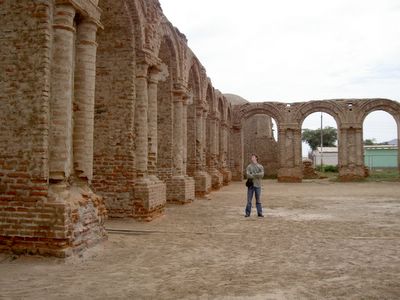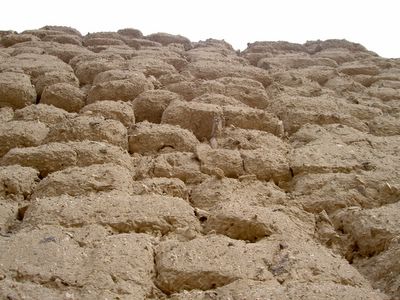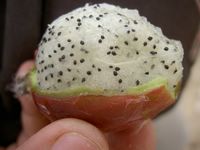Diane: Zaña was a well-to-do colonial town in the 1500's, perhaps the most wealthy in all of Peru at the time. Today the ruins of the most prominent churches are all that remain of the town's former opulence. You can tell they must have been humdingers!
Early in Colonial times, the Spanish brought in African slaves to work on sugar plantations, who retained some significant part of their culture. Perhaps due to their different customs, the rest of the country came to think of Zañans as being morally corrupt. Or perhaps, their wealth led to a moral decline. Although there is disagreement on this, it is clear that an El Niño came through in 1720, flooding the town and leaving it in ruins. It was popularly thought of as a divine punishment for their evil ways.
Interestingly, the Sicán people had a similar legend. According to the legend, the last Naymlap king committed a series of sins culminating in a great flood. The facts are that the Sicán people abandoned their capital in 1050 A.D. and built an even larger one in Túcume. Perhaps the floods of an El Niño phenomenon led to their desire for a new location for the capital. As with Zaña, the legend blames the flood on immoral behavior.
Just outside of Zaña, we walked to some Pre-Incan ruins. There hasn’t been much interest from archaeologists in the site, so for all we know, it could be an unstudied civilization. Perhaps it too was disrupted by El Niño floods. All that is left are some walls constructed from adobe bricks.
And a huge number of huaquero (grave-robber) holes. The whole area is an enormous checkerboard of square holes.
There are pottery shards littering the area. Both TM and Tom spent some time sifting the sand to see what they could find. Tom found some decorated ceramic fragments. TM found what looked like copper or bronze depilatory tweezers like the ones we saw in nearby museums and a lot of shells. Note the dirty fingers and dusty jeans.
Micky and I checked out some of the cactus and cactus fruit growing nearby.
 |  |
We then turned our attention to some huge, hopping beehives. The bees formed a thick blanket on the plants they chose for their hives. Unfortunately, a few of the bees turned their attention back toward us.


No comments:
Post a Comment